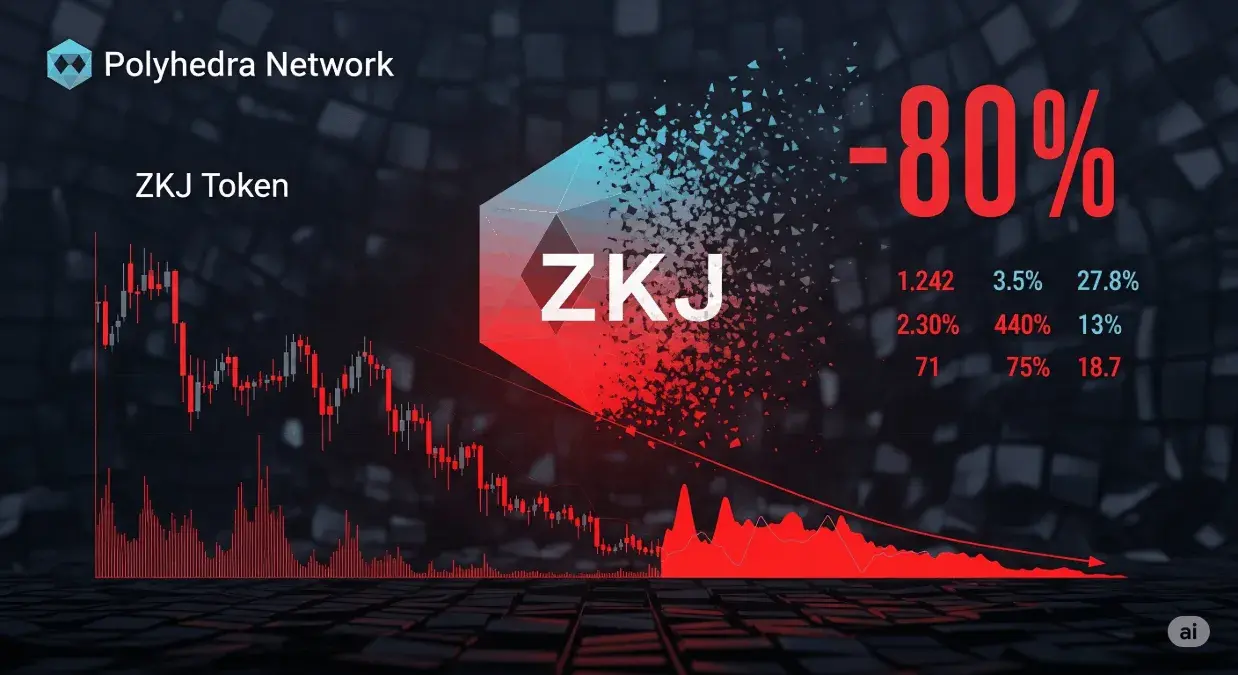Polyhedra Network’s ZKJ Token Plummets 80%: A Deep Dive into Market Volatility and Manipulation Concerns

The cryptocurrency market, renowned for its unpredictable swings, recently witnessed a dramatic event that sent shockwaves through the community: the Polyhedra Network’s ZKJ token experienced a staggering 80% plummet in value within a mere 24 hours. This sharp decline pushed the token to historic lows of $0.26, a stark contrast to its all-time high of $9.56 reached in March 2024. The incident has not only inflicted millions of dollars in losses on traders but has also ignited widespread concerns about market manipulation and the inherent risks within decentralized ecosystems.
The Unraveling of ZKJ: A Cascade of Sell-Offs and Liquidity Drain
The immediate trigger for ZKJ’s precipitous fall was an unusual and intense wave of sell-offs coupled with significant liquidity withdrawals. The ZKJ/KOGE trading pair, in particular, bore the brunt of this activity, largely due to its involvement in Binance’s Alpha Points program, which offered shared incentives. This sudden and severe depletion of liquidity acted as a catalyst, initiating a domino effect of liquidations that caught numerous traders off guard. The rapid cascade of forced sales amplified the downward pressure on ZKJ, creating a feedback loop that further exacerbated its decline.
The implications of this liquidity crunch were immediate and severe. Traders who had leveraged positions found themselves facing massive losses, with the collective impact reaching into the millions of dollars. Beyond the financial repercussions, the incident has dealt a significant blow to investor confidence, prompting a collective reevaluation of risk management strategies within the volatile crypto landscape. The sheer speed and magnitude of the drop left many questioning the stability and fairness of certain market mechanisms, especially those involving incentive programs that might inadvertently create vulnerabilities.
Market Dynamics and Suspicious On-Chain Activity
The daily trading volume for ZKJ reflected the nervous sentiment pervading the market, falling by a substantial 61% and settling around $1.23 billion. This significant reduction in trading activity underscored the widespread trepidation among investors, many of whom opted to sit on the sidelines rather than engage with the volatile asset. Such a sharp decline in volume is often indicative of a crisis of confidence, where market participants become hesitant to enter or maintain positions due to uncertainty and fear of further losses.
While the drop partially coincided with broader international geopolitical tensions, which can naturally dampen risk appetite across financial markets, on-chain data painted a more unsettling picture. Analysis of these data revealed coordinated movements among large wallets, raising red flags about potential market manipulation or sophisticated value extraction strategies. Such synchronized actions by major holders, often referred to as “whales,” can exert immense influence on token prices, especially in markets with lower liquidity. The suspicion of deliberate exploitation of market weaknesses suggests a more sinister underlying cause for ZKJ’s crash than mere market corrections or external economic pressures. This aspect of the event highlights the ongoing challenge of ensuring fair and transparent practices within the often-unregulated decentralized finance (DeFi) space. The coordinated nature of these movements raises questions about whether certain entities leveraged their significant holdings to trigger a sell-off, profiting from the subsequent price collapse at the expense of smaller, less informed traders.
Binance’s Swift Response and Regulatory Adjustments
In the wake of the ZKJ debacle, Binance, one of the world’s leading cryptocurrency exchanges, acted swiftly to address the vulnerabilities exposed by the incident. Recognizing the potential for risk concentration and to foster a more equitable trading environment, Binance announced an immediate update to its Alpha Points rules. Effective June 17, 2025, trading volume between Alpha tokens such as ZKJ and KOGE will be excluded from the Alpha Points program. This strategic measure aims to disincentivize the kind of artificial volume generation and concentrated trading that may have contributed to the recent liquidity crisis. By removing the incentives for such paired trading, Binance seeks to promote more organic and balanced market participation, thereby reducing the likelihood of similar events occurring in the future.
This swift regulatory adjustment by Binance is a crucial step towards mitigating systemic risks within its ecosystem. It underscores the responsibility of major platforms to continuously monitor and adapt their policies to safeguard market integrity and protect users. While the changes directly address the specific mechanism that may have been exploited, they also serve as a broader signal to the market that exchanges are actively working to prevent manipulative practices and create a healthier trading environment.
Adding another layer of complexity to Polyhedra Network’s recovery prospects is the impending release of over 15 million ZKJ tokens. This significant influx of new tokens into the market is expected to exert additional short-term selling pressure. The increased supply, without a corresponding surge in demand, could further suppress ZKJ’s price, making a rapid recovery more challenging. This token unlock schedule, while often pre-planned, becomes a critical factor in times of market distress, as it can intensify existing downward trends. The combination of regulatory changes and tokenomics presents a formidable challenge for Polyhedra Network as it navigates the path towards stabilization.
The Uncertain Path Ahead for Polyhedra Network
The technical outlook for ZKJ remains shrouded in uncertainty. Current indicators suggest that the price could continue its downward trajectory, potentially falling below the $0.25 mark. This pessimistic outlook is fueled by the sustained lack of liquidity, the lingering investor distrust, and the impending token unlock. Traders and analysts are closely monitoring key support levels, and a breach of these could signal further declines. The market sentiment is fragile, and any further negative news or lack of concrete recovery plans from Polyhedra Network could amplify the selling pressure.
However, a glimmer of hope exists for Polyhedra Network. A moderate recovery could materialize if liquidity returns to the market and overall conditions stabilize. Should new investors enter, or existing holders regain confidence, ZKJ’s price could potentially settle within a range of $0.30 to $0.40. This recovery, however, would likely be gradual and contingent on several factors, including broader market sentiment towards cryptocurrencies, the successful implementation of Polyhedra Network’s recovery strategies, and a renewed belief in the project’s long-term viability. The path to recovery for Polyhedra Network is not merely about price action; it’s about rebuilding trust and demonstrating resilience in the face of adversity.
Polyhedra Network, for its part, has reaffirmed the strength of its core technology, assuring its community that the underlying architecture remains robust. The team is reportedly reviewing the recent episode meticulously, with the aim of reinforcing the network and implementing measures to prevent future vulnerabilities. This commitment to introspection and improvement is vital for rebuilding investor confidence. The incident serves as a critical learning experience, inviting broader reflection on risk management within decentralized ecosystems and the profound influence that large players can exert on market dynamics. The ZKJ crash underscores the need for robust decentralized governance, transparency, and effective mechanisms to mitigate the impact of coordinated actions by whales.
Currently, ZKJ is trading around $0.3820, with a market capitalization hovering near $111.87 million. This represents a significant contraction from its peak market valuation, reflecting the severe impact of the recent price depreciation. The unfolding of this situation will be a pivotal moment for Polyhedra Network, serving as a crucial test of its resilience and its future standing within the competitive and ever-evolving crypto space. The ability of Polyhedra Network to learn from this challenging experience, adapt its strategies, and reassure its community will determine its long-term viability and its capacity to regain lost ground. The entire crypto community will be watching closely to see how Polyhedra Network navigates these turbulent waters and whether it emerges stronger from this ordeal.
Broader Implications for the Crypto Ecosystem
The ZKJ incident with Polyhedra Network extends beyond the immediate financial losses and serves as a cautionary tale for the entire cryptocurrency ecosystem. It highlights several critical issues that the industry must collectively address to mature and gain broader mainstream acceptance. Firstly, the incident underscores the inherent risks associated with highly leveraged positions and concentrated liquidity within specific trading pairs. While incentive programs like Binance’s Alpha Points aim to foster activity, they can inadvertently create single points of failure if not carefully designed and monitored. This calls for a re-evaluation of how such programs are structured to prevent excessive risk concentration and potential manipulation.
Secondly, the suspicions of coordinated movements among large wallets reignite the ongoing debate about market manipulation in decentralized finance. While the ethos of DeFi promotes decentralization and transparency, the concentration of wealth in a few hands can still lead to behaviors that undermine fair market practices. The industry needs to explore more robust mechanisms for detecting and potentially mitigating such coordinated actions, without compromising the core principles of decentralization. This could involve enhanced on-chain analytics, community-driven monitoring, or even more sophisticated decentralized governance models that can react swiftly to unusual market behavior.
Furthermore, the ZKJ crash emphasizes the need for continuous vigilance and adaptation from centralized exchanges like Binance. Their role in maintaining market integrity is paramount, and their swift response to update rules demonstrates a willingness to evolve. However, the incident also prompts questions about proactive measures that can be put in place to prevent such events from occurring in the first instance. This could include more rigorous vetting of tokens participating in incentive programs, or real-time monitoring of liquidity pools for sudden and unexplained withdrawals.
Finally, for individual investors, the Polyhedra Network situation serves as a stark reminder of the importance of thorough due diligence and robust risk management. The allure of high returns in the crypto market often overshadows the inherent volatility and potential for sudden downturns. Diversification, understanding the tokenomics of projects, and avoiding over-leveraging are crucial strategies for navigating this complex landscape. The ZKJ incident is a powerful lesson in the adage of “not putting all your eggs in one basket” and the critical need to be prepared for unexpected market shocks. The ability of investors to critically analyze on-chain data and understand the potential impact of large wallet movements is becoming increasingly important for making informed decisions.
In conclusion, the Polyhedra Network ZKJ crash is more than just a blip on the radar; it is a significant event that will undoubtedly shape discussions around market structure, regulatory oversight, and investor protection within the crypto space. The resilience of Polyhedra Network and the industry’s collective response to such challenges will be crucial in defining the future trajectory of decentralized finance and its journey towards widespread adoption. The lessons learned from this episode will likely influence how future projects are designed, how exchanges operate, and how investors approach risk in this dynamic and ever-evolving market.
Looking Ahead: The Road to Recovery and Resilience
The immediate future for Polyhedra Network is undeniably challenging. The token’s price action will be heavily influenced by several factors: the market’s absorption of the impending 15 million ZKJ token release, the return of investor confidence, and the broader sentiment across the crypto market. A sustained period of stability, coupled with transparent communication from Polyhedra Network regarding their corrective actions and future plans, will be critical for any meaningful recovery. The team’s commitment to reinforcing the network and preventing future vulnerabilities is a positive sign, but the implementation and effectiveness of these measures will be closely scrutinized by the market.
For the wider crypto ecosystem, the Polyhedra Network incident underscores the ongoing need for robust risk management frameworks. As decentralized finance continues to innovate and expand, the complexities and interconnectedness of various protocols and incentive programs will only increase. This necessitates a proactive approach to identifying potential systemic risks and developing mechanisms to mitigate them before they lead to widespread market instability. The incident also serves as a reminder that while decentralization offers numerous benefits, it does not inherently eliminate the potential for manipulative behaviors or the need for vigilant oversight, whether through centralized entities like exchanges or through community-driven initiatives.
The experience of Polyhedra Network will likely become a case study in market volatility and the impact of concentrated liquidity and potential manipulation. How Polyhedra Network rebuilds trust and navigates its path forward will be a testament to its long-term viability and the resilience of its underlying technology. The lessons learned from this episode will undoubtedly contribute to the ongoing evolution of risk management practices, regulatory considerations, and investor education within the dynamic world of cryptocurrency. The journey ahead for Polyhedra Network is a crucial one, not just for the project itself, but for the broader narrative of stability and maturity in the crypto market. The ability of Polyhedra Network to not only survive this challenge but to emerge stronger will be a significant indicator of its enduring potential in the competitive blockchain landscape.
Stay informed, read the latest crypto news in real time!
Ultimately, the ZKJ plummet serves as a powerful reminder that while the crypto market offers immense opportunities, it also demands a high degree of caution, understanding, and preparedness for rapid and unexpected shifts. The future of Polyhedra Network and similar projects will hinge on their capacity to adapt, innovate, and most importantly, to build and maintain the trust of their communities in an increasingly scrutinized and evolving financial frontier.





